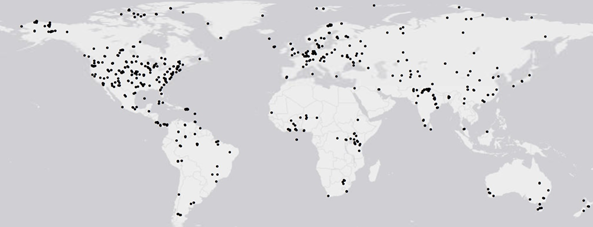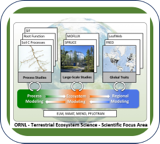Leveraging Root Functional Traits to Inform Terrestrial Biosphere Models
Roots from all ecosystems are poorly represented in terrestrial biosphere models (TBMs), leading to a disconnection between data streams collected by ecologists and model representation of belowground processes.
Reasons for the overly-simplistic representation of roots include:

- poor empirical understanding (and therefore representation) of important processes at scales at which TBMs operate,
- limited communication among empiricists and modelers, and
- lack of data from ecosystems spanning the globe.
The overarching goal of the multi-discipline Root Function Team (plant, soil and hydrological modelers, scientists and data managers) is to use a ModEx approach to improve the representation of fine roots in TBMs in order to better project responses of terrestrial ecosystems to global change.
Integrating Root Functional Dynamics into Models
In a comprehensive literature review models (Warren et al. 2015), we described the current state of root representation in models at multiple scales, ranging from mechanistic processes at the scale of a single root to parameterized root processes operating at the landscape scale. We further discussed how existing and future root functional knowledge, new data compilation efforts, and novel modeling platforms can be leveraged to enhance root functionality in large-scale terrestrial biosphere models. Both improved parameterization within models, and the introduction of new model components such as dynamic root distribution and root functional traits linked to resource extraction, are needed.
Leveraging Root Traits to Inform Terrestrial Biosphere Models -- Let's talk about FRED
Evidence suggests that the spectrum of plant strategies integrates across leaves, wood, and roots, and a rising tide of data is exposing important linkages between species-specific root traits and important root functions. Building on knowledge gained in our literature review, we aim to improve the representation of fine roots in TBMs by facilitating modeling approaches that embrace the inherent variation and tradeoffs in plant traits in response to current and future environmental conditions.
We focus on three trait-enabled tasks:
- Improving the parameterization of root traits in model plant functional types, which requires a wealth of trait data for species spanning the globe. We are currently compiling the Fine-Root Ecology Database (FRED) from published literature and unpublished data; currently, FRED houses ~7000 observations from across the globe of structural and functional root traits and their associated edaphic and environmental conditions.
- Performing analyses of model sensitivity to variation in root traits derived from FRED in an easily-accessed “root module” developed using the Functional Unit Testing platform in collaboration with D. Wang.
- Improving model structure to better reflect known root distribution, dynamics, and function across the globe. The state of science in the root and rhizosphere community is a focus on differences in root form and function across root orders from the most distal fine-root tips, which are known to be active in water and nutrient uptake and are colonized by mycorrhizae, to higher-order fine roots that are mainly responsible for solute transport.

Map of locations currently in the Fine-Root Ecology Database (FRED).
Root Traits to Function
Our literature review developed a framework to improve fine-root representation in large-scale models through new data compilation and collection efforts, scaling and modeling. Building upon this framework, we will leverage and develop focused field, laboratory, and mechanistic model-experiment interactions to link key root processes with root traits, and to validate root functional responses to environmental conditions. A primary component of these efforts will be quantifying root function for key root traits based on existing data and new experiments. Combining our knowledge of root traits for a given PFT with specific root functions (i.e., water and nutrient uptake kinetics, and C release through respiration, exudation and turnover), will allow us to link traits with function that can be scaled to the landscape level.
Objectives for this task are:
- Initially assess state of knowledge of trait-specific nutrient and water uptake kinetics.
- Where justified by our modeling and data analyses, initiate new experimental systems to quantify trait-specific root and water uptake kinetics.
- Leverage new and existing data related to nutrient or water extraction patterns for use in modeling exercises.
Results
We developed a comprehensive review manuscript that assesses current and future incorporation of root structure and function into models (Warren et al. 2015). A variety of different modeling recommendations emerged from the study, including:
- the need to develop functional modules that represent specific root processes,
- pairing detailed root trait data (e.g., minirhizotron-sourced root dimensions and distribution) with soil water and nutrient extraction patterns in reactive transport models such as PFLOTRAN, and
- the need for additional sensitivity analysis to determine if inclusion of additional root processes in models would improve the outcome.
We led a number of international workshops focused on roots and belowground process representation in models, including a successful workshop at ORNL in June, 2014, on the ‘Improved Representation of Roots in Models’ and an Organized Oral Session at the 2014 Ecological Society of America meeting, “A Path Forward for Improved Representation of Fine Roots in Large-Scale Models: Linking Models, Data, and Experiments.” We also initiated the creation of a much-needed root trait database to provide novel synthesis of root data and to aid model development, one of the key workshop recommendations, and to continue the development of a ‘root module’ in the Community Land Model, which will allow root scientists to access and experience model treatment of root processes.
Publications, Workshops, and Organized Sessions
- Warren, JM, Hanson PJ, Iversen CM, Kumar J, Walker AP, Wullschleger SD. 2015. Root structural and functional dynamics in terrestrial biosphere models – Evaluation and recommendations (Tansley Review). New Phytologist 205: 59-78.
- Workshop: ‘Roots in Models’ workshop held at Oak Ridge National Laboratory, TN, USA in June, 2014, and funded by the Department of Energy, Office of Science (http://web.ornl.gov/~ciz/Roots_in_Models.html).
- Session: ‘A path forward for improved representation of fine roots in large-scale models: Linking models, data, and experiments’. Organized Oral Session at the annual Ecological Society of America meeting, August, 2014, in Sacramento, CA, USA (http://eco.confex.com/eco/2014/webprogram/Session9688.html).

